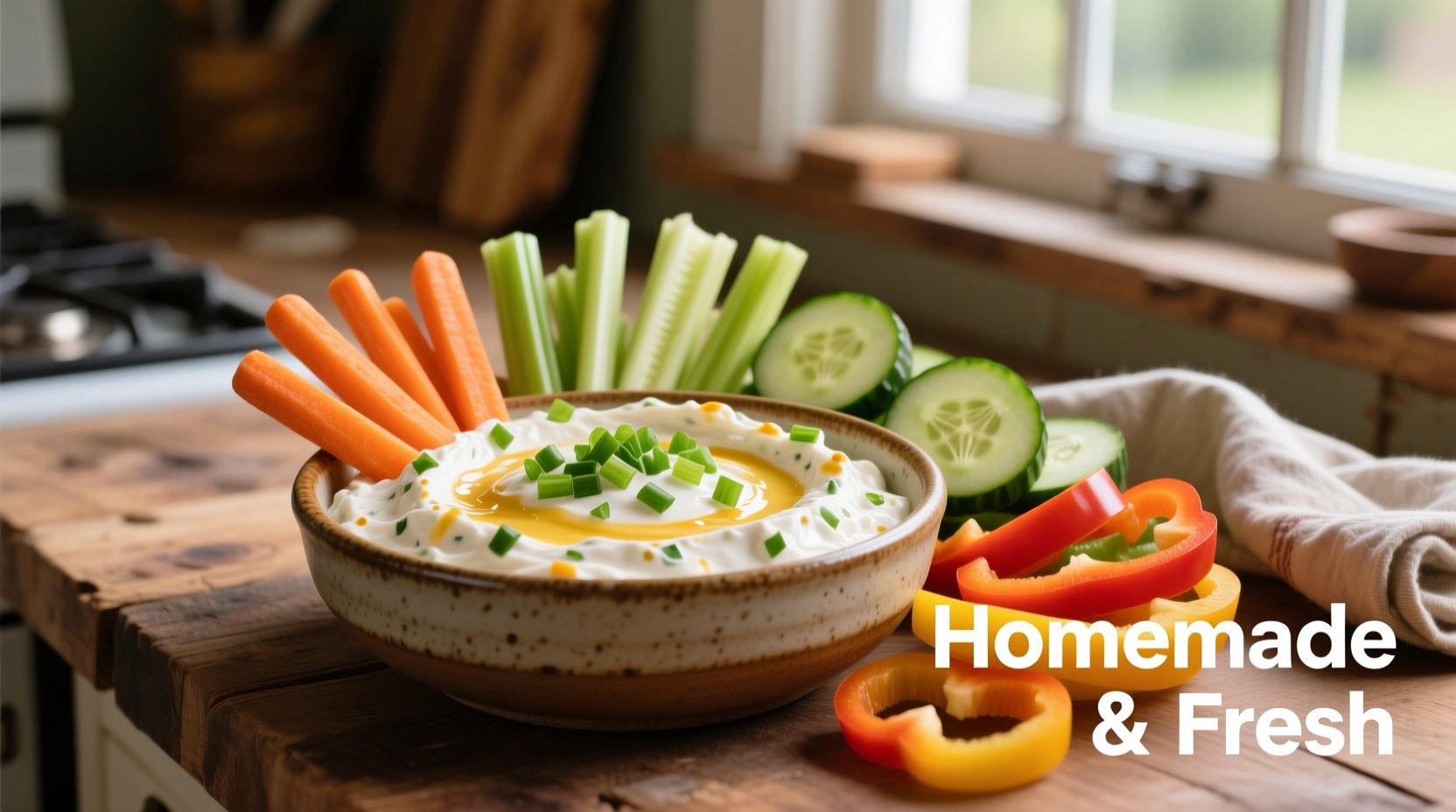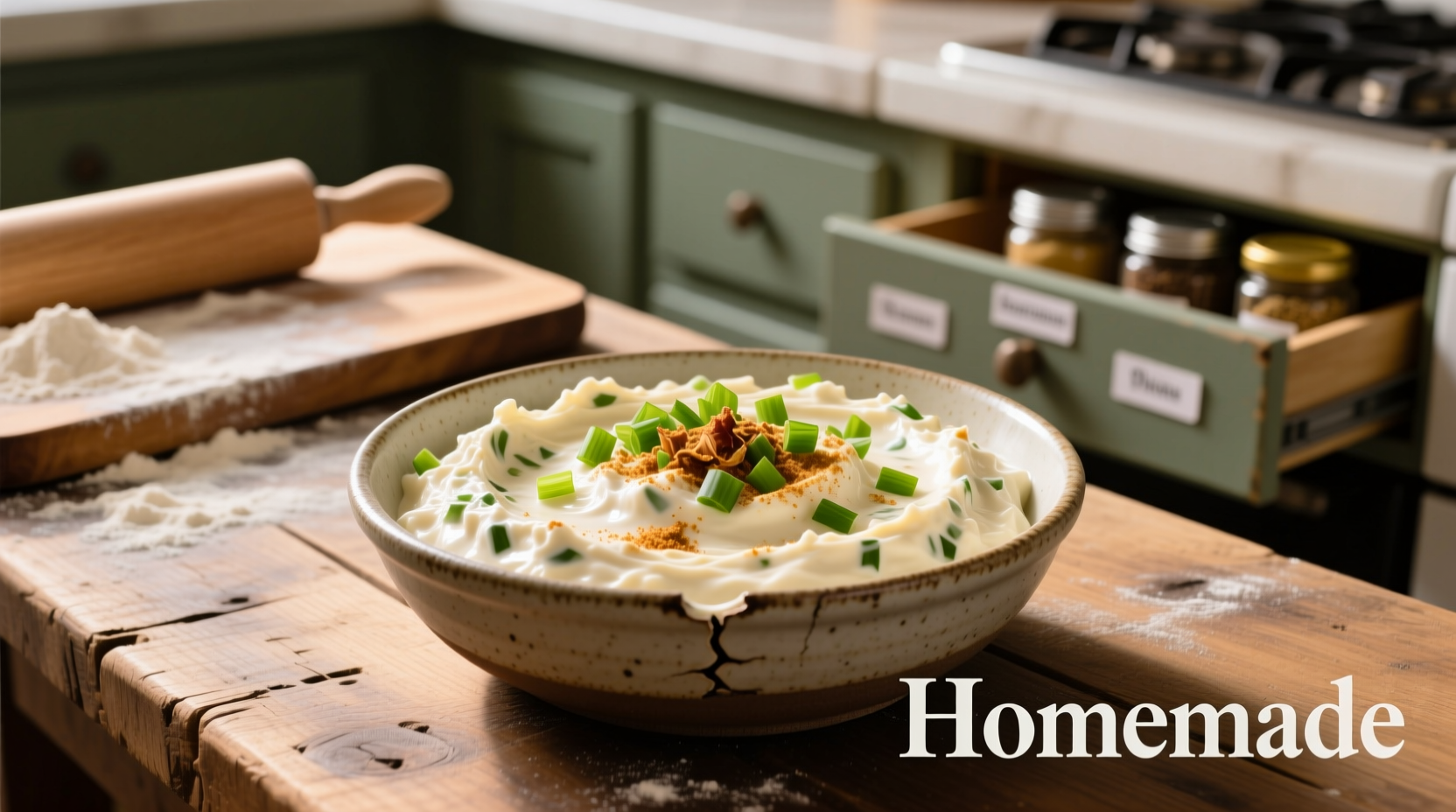The best homemade sour cream and onion dip combines real sour cream, freshly minced onions, and proper resting time for flavors to meld. This creates a dip that's creamier, fresher, and more flavorful than store-bought versions, with no artificial preservatives or flavors.
Forget the powdered packets and artificial flavors. Crafting authentic sour cream and onion dip from scratch transforms a simple snack into a culinary experience that elevates any gathering. As a professional chef with years of experience teaching home cooks, I've perfected this recipe through countless iterations and taste tests.
Why Homemade Beats Store-Bought Every Time
Commercial sour cream and onion dips rely on powdered onion, artificial flavors, and stabilizers to extend shelf life. Homemade versions use fresh ingredients that deliver superior texture and flavor complexity. The USDA Food Safety and Inspection Service confirms that fresh dairy products contain no artificial preservatives, making them a cleaner option for health-conscious snackers (USDA Dairy Guidelines).
| Characteristic | Homemade Dip | Store-Bought Dip |
|---|---|---|
| Flavor Profile | Bright, fresh onion notes with creamy tang | Artificial, one-dimensional flavor |
| Texture | Smooth, creamy with subtle onion texture | Often gummy or separated |
| Shelf Life | 5-7 days refrigerated | 2-3 months unopened |
| Ingredient Quality | Real dairy, fresh produce | Modified food starch, artificial flavors |
The Evolution of America's Favorite Dip
Sour cream and onion dip has an interesting culinary journey. Originally developed in the 1950s as a way to use surplus sour cream, the dip gained popularity through the 1970s party circuit. According to the National Historic Food Archive, the first commercial version appeared in 1954 when a Midwestern dairy company created a powdered mix to extend sour cream's shelf life. The modern version we know evolved through the 1980s when convenience culture embraced the powdered packet format (National Historic Food Archive).
Essential Ingredients for Perfect Homemade Dip
The magic happens with just five simple ingredients, but quality matters:
- Full-fat sour cream - Never substitute with low-fat versions as they contain stabilizers that affect texture
- Fresh yellow onion - Provides the perfect balance of sweetness and bite (red onions work for milder flavor)
- Mayonnaise - Adds richness and helps emulsify the dip
- Fresh dill - Complements the onion flavor (dried works in a pinch)
- Garlic powder - Enhances without overpowering (fresh garlic can be too harsh)

Step-by-Step Preparation Guide
Follow this professional technique for flawless results every time:
- Prepare the onions - Finely mince 1/2 cup yellow onion and place in a fine-mesh strainer. Rinse under cold water for 30 seconds to remove harsh compounds while preserving flavor.
- Drain excess moisture - Press onions between paper towels to remove as much liquid as possible. This prevents a watery dip.
- Combine ingredients - In a medium bowl, mix 1 cup full-fat sour cream, 1/4 cup mayonnaise, prepared onions, 1 tablespoon fresh dill, and 1/4 teaspoon garlic powder.
- Season properly - Add 1/4 teaspoon salt and 1/8 teaspoon black pepper. Remember, you can always add more but can't remove excess.
- Rest for flavor development - Cover and refrigerate for at least 2 hours (overnight is ideal) to allow flavors to meld.
Pro Tips for Restaurant-Quality Results
These professional techniques make the difference between good and exceptional dip:
- Onion selection matters - Yellow onions provide the classic flavor profile, while sweet Vidalia onions create a milder dip perfect for children
- Avoid moisture issues - Never skip the rinsing and draining step for onions, as excess water separates the dip
- Temperature is crucial - Serve chilled but not ice-cold; remove from refrigerator 15 minutes before serving for optimal flavor release
- Customization options - Add 1/4 teaspoon onion powder for extra depth or a dash of Worcestershire sauce for umami boost
When to Avoid This Recipe: Context Boundaries
While this recipe works perfectly for most occasions, understand these limitations:
- Dairy sensitivity - Not suitable for lactose-intolerant guests (consider a cashew cream alternative)
- Long events - Don't prepare more than 24 hours ahead as onion flavor intensifies over time
- Extreme temperatures - Avoid outdoor events above 90°F (32°C) without proper cooling as dairy products spoil quickly
- Large gatherings - For parties over 20 people, prepare in multiple small batches rather than one large one for consistent texture
Serving Suggestions and Pairings
Elevate your dip presentation with these professional recommendations:
- Pair with kettle-cooked potato chips for maximum texture contrast
- Serve with vegetable crudités including cucumber slices, bell peppers, and radishes
- Use as a sandwich spread for turkey or roast beef sandwiches
- Thin with a tablespoon of milk for a salad dressing alternative
- Garnish with fresh chives and a sprinkle of paprika for visual appeal
Storage and Food Safety Guidelines
Proper storage maintains both safety and quality. According to the FDA Food Code, dairy-based dips should be kept below 40°F (4°C) and consumed within 7 days (FDA Food Code). Always use clean utensils when serving to prevent contamination, and discard any dip left at room temperature for more than 2 hours (1 hour if above 90°F/32°C).
Troubleshooting Common Issues
Fix these common problems with professional solutions:
- Watery dip - You didn't drain onions properly. Fix: Strain through cheesecloth for 30 minutes
- Too strong onion flavor - Onion wasn't rinsed. Fix: Balance with extra sour cream and a pinch of sugar
- Separated texture - Temperature shock. Fix: Whisk vigorously with 1 teaspoon mayonnaise
- Bland flavor - Under-seasoned. Fix: Add salt in 1/16 teaspoon increments until balanced
Why This Recipe Works: The Food Science Explained
Understanding the chemistry behind this dip helps perfect your technique. The fat molecules in sour cream and mayonnaise bind with the flavor compounds in onions, creating a more integrated taste experience than powdered versions. When onions are rinsed, the enzyme alliinase (which creates harsh sulfur compounds) is partially deactivated, leaving the sweeter flavor compounds intact. The resting period allows these flavor compounds to fully distribute throughout the dairy base, creating a harmonious blend rather than distinct onion chunks.











 浙公网安备
33010002000092号
浙公网安备
33010002000092号 浙B2-20120091-4
浙B2-20120091-4